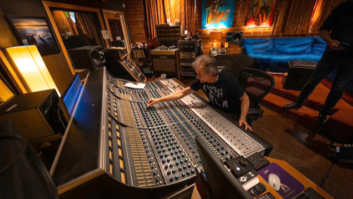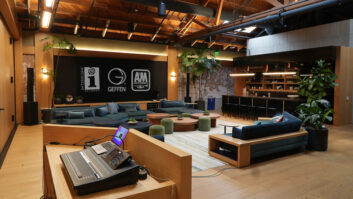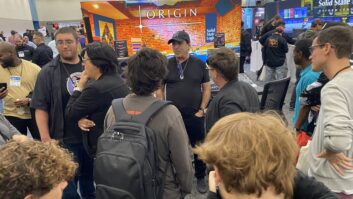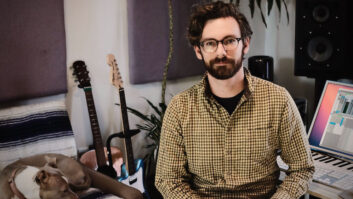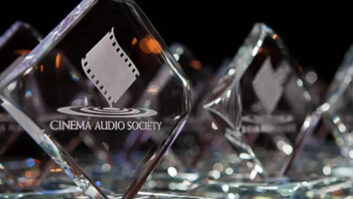It took a while to catch up with top music scoring mixer Alan Meyerson. This year was less than half over and already he’d been behind the board for several very big movies, including Catwoman, Shrek 2, Man on Fire and Kill Bill Vol. 2. Dealing with the tight production schedules and ultrahigh pressure that are now de rigueur on major motion pictures is nothing new for Meyerson; you’ve heard his work on many of them, from Crimson Tide, Speed and Traffic to Black Hawk Down, The Italian Job, Pirates of the Caribbean, Pearl Harbor, Gladiator, Shrek and many more.
Music scoring is a rarefied world in which the quest for high-quality sound remains unrelenting. There are expensive musicians (often lots of them!), expensive gear, expensive scoring stages and, frequently, brutal time constraints. Add to that the demanding personalities inherent to such high-stakes creative situations: directors, composers and studio executives. This is not a business for the fainthearted.
But Meyerson seems to thrive on the job’s pressure. He was certainly enjoying himself the day I corralled him at the Newman Stage on the Fox Pictures lot in L.A. The session was for Steam Boy, a high-profile Japanese anime directed by Katsuhiro Otomo, who’s widely credited with being the founder of the genre. Meyerson was co-producing [with Kei Momose] the soundtrack, and the day was dedicated to the percussion section of doom: an all-star collaboration with top session and touring cats Michael Fisher, Alex Acuna and Luis Conte that featured an array of priceless taiko drums, darabuka, tambourine sticks and countless other exotic instruments.
A bit of background: You started out as a record-making engineer. How did you transition to film scoring?
I’d gotten to the point where I was tremendously frustrated with the record business. It seemed like the era for my style of mixing had come to a close. I wasn’t a good fit for hip hop and I was considering other directions. I was at a party one night with my manager at the time, and, jokingly, I said that maybe I should meet someone like Hans Zimmer. Nothing came of it, but later, just by coincidence, one of my neighbor’s kids got an apprenticeship at [Zimmer’s company] Media Ventures. As it happened, Hans had a partner at the time that I’d known from when I lived in New York, so I told the kid to say “Hi” for me. He did, and Media Ventures ended up calling me and asking me to drop by. Long story short, I did a little overdub session with Hans. He was pretty happy and the rest, as they say, is history.
Back to the present: What’s your microphone setup for today’s session?
For a session like this, it’s important to have superclean, low-distortion mics for close-miking. I use a combination of Schoeps CMC6 amplifiers with MK4 cardioid capsules and Sennheiser MKH 80s. I also have a pair of mid-distance mics; in this case, I used my Brauners. My surround mics are basically a Decca Tree LCR: two surround mics and a dedicated LFE [low-frequency energy] or subwoofer mic. I’m using Neumann M150s on the LCR, Sennheiser MKH 800s on the left and right surround, and a Neumann TLM 170 for the LFE. I mix them down to either 5.1 plus stereo close mics or LCR plus stereo close mics.
Today, we’re basically doing three passes per cue: one each of low stuff like taikos or frame drums, one of mid stuff or “skins” like djembes or cajons, and one of high stuff like shakers or tambourine sticks. All three musicians play on each pass. We just build this ungodly noise that I can have fun with in the mix!
How many tracks are you recording and what’s on them?
By the end of today, there will probably be 20 to 25 tracks of percussion per cue.
What is your basic orchestral mic setup these days?
It changes all the time, but my starting point is pretty conventional for film score. I’ll use a Decca Tree configuration for my main LCRs with wide mics left and right. I tend to use four spot mics on the violins — no matter the size of the section — two viola mics, two cello mics and then a bass mic per stand. Other than the first bass mic, which I keep pretty loud, the spot mics are there only to help articulate a part when needed. Otherwise, they’re either very low or extinguished.
I tend to use stereo woodwind miking that is above and in front of the section. I do record woodwind spots, but I only use them in an emergency. The French horns take care of themselves in the room mics, but I record a French horn feature mic. For the brass, I’ll record a brass feature about 10 feet in front of the whole section, at the same height as the Decca Tree. I use the tuba and bone spots somewhat. The trumpet mics stay off most of the time.
Would you consider your sound to be preamp-dependent?
I do have my own preamps: 30 channels of Grace, eight channels of Neve 1063s and six channels of Fred Forssell’s Fetcode. Fred made the Millennia tube-side of the Twin Topology, and at one point, he decided to build his own. In a case like today’s percussion session, where there are a lot of level changes, I like the Grace because it’s remote-controlled. I’ve got the amplifiers outside in the studios and the controllers inside the control room.
You work at a lot of different studios.
Yes, but I’m still based out of Remote Control [formerly called Media Ventures]. Not only is it a great place, but I have all my gear there! I love the people and the quality of the mixes I get there. And I love the Euphonix System 5 console. With the System 5, in conjunction with the Sony Oxford compressors and EQ that I’ve been using lately, I’m set. I don’t need to use much of anything else.
But what about all your other gear?
Really, the only thing I still use [hardware] a lot for is bus EQ or compression. Across the orchestra, I’ll tend to do some bus EQ and occasionally I’ll use some bus compression across the overall LCRS of different groups. And when I mix, I always have my Manley Massive Passives across the orchestra. I also have two matched Neve 2254s that I tend to put across the percussion bus, just for a little tickling to make things a little louder. I sometimes use my Avalons for synths or solo stems. I also still love my TC Electronic 6000 as an orchestra reverb, but otherwise, there’s just too much good stuff available in the computer now: effects, EQ, even compressors.
Not to beat the drum, but the Oxford compressor is really fantastic. It gives you a beautiful “overall.” I also love the multiband compression that’s available now. I love the Waves C4 because it has so much control for de-essing on vocals and because I can find frequencies to pop out on percussion or guitar. It’s like the old trick you can do with the Brook Siren 902. That’s the greatest bass compressor in the world because it doesn’t touch anything except the frequencies it really needs to control, like the “wolf” tones on bass. Now that kind of control is available to everyone with multiband.
Something I just bought is the Princeton digital reverb, the Eventide 2016 emulation plug-in. It’s unbelievable how good it is. Maybe I’ve forgotten what the original 2016 sounds like, but the emulation is exactly what I was looking for when I was no longer able to find a good 2016.
I don’t have a tremendous amount of vintage stuff. I have a rack of Neve EQs, a couple of Neve compressors and a couple of Pultecs.
Is that because for recording orchestras you can’t risk the unreliability of older equipment?
Absolutely. And also, especially with microphones, it’s because the self-noise floor of modern mics has gotten so low. I have three Dirk Brauner/Klaus Heyne tube mics that Dirk built and Klaus modified with an incredibly low noise floor. Royer powered ribbon mics are great that way also. With these kinds of mics, you can get the noise floor of a multi-miking situation, like an orchestra, far below where it used to be.
With analog tape, the tape was your definition for where the noise floor was, but it’s a new world. When I break out my rebuilt [Neumann] M49s, which sound wonderful, there’s a huge difference in the level of the noise. So now I use them more like a solo or feature mic that I’m going to turn on and off rather than leaving them open all the time.
What are some of the mics you use a lot?
Soundelux E47s, mostly on basses, and Sennheiser MKH 800s. The Sennheisers have five patterns. They also have frequency boosts, which is great when you’re doing distance-miking where you’re going to lose high frequencies through friction. If you use them as surround mics and just put the 3dB boost at 6k on, the boost puts a little of what’s lost back without sounding EQ’d. I like that because I try not to EQ anything when I record orchestrally.
When I record a rhythm section, of course, I EQ, but not orchestras. As a matter of fact, I don’t even really touch the signal anymore! I’ve gotten to the point where I come right out of the preamp into Pro Tools. I don’t really use buses unless it’s a huge orchestra. Maybe I’ll combine bass mics. Other than that, I hardly touch the board anymore during recording. Fortunately, or unfortunately, for me, during recording the console has become a very big, very expensive monitor desk.
It’s all about the mics and the preamps.
Yeah, and with the Grace remote-control preamp, I can store the settings, so if I come back in to do a pickup session, everything is the same. I’m spoiled. The Grace preamps are fantastic, superclean and great for spot mics.
But for mixing, you’re a heavy plug-in user.
I like processing things, especially because the scores I tend to work on, which I guess the industry calls “hybrid,” have a lot of synths and synth percussion: elements that live in the composer’s room before the music comes to me. There’s a lot of processing involved and you need to have repeatability. If you’re doing a big movie with 40 cues, to have to create all those sounds on the fly and then to have to change stuff from cue to cue is really a hassle. It’s a lot easier to do it in the box than to try and do it on a console.
With Hans, we don’t print anything anymore, plug-in — wise. Instead, when he’s writing, he’ll EQ and add reverb on the return. I have all the plug-ins that he has in his room duplicated in the mix room. When I open up a session, at least plug-in — wise, I start from his point of view, which is a tremendous advantage. If I had to unravel a 150-track Hans Zimmer pre-record from scratch, I would never finish. Instead, I start from where he left off and see what I can do to make it better.
Plug-ins, of course, have gotten worlds better in the last couple of years. And there’s the whole “apparent” loudness trend that’s going on with compression that’s more frequency-based. It’s not as obvious as over-compression; it’s more subtle. The Sony Inflator, Crane Song’s Phoenix and Renaissance have a vocal compressor that’s literally like an L1: You just pull one knob and it gets louder, but in a good way. It’s actually pretty cool.
I especially like the Inflator. On Last Samauri, there was a cue where I just couldn’t get the mix right. When I went into Hans’ writing room and listened, I realized he had an Inflator across his stereo bus. When I took the Inflator out, it was dead. I couldn’t duplicate exactly what he did because I didn’t have a stereo bus, but I’ve started using Inflators across individual tracks. That way, I can match Hans’ sound, with the ability to be a little pickier about how much processing to use.
All of these things work great in moderation and all of the subtleties add up. It amazes me how little you can change things and still make a huge difference. That’s something I find with my Massive Passives that I put across the orchestra bus and across percussion just a little bit. If you listen before and after, it makes this tremendous difference. Besides the EQ itself, I think it’s that little bit of the saturation that happens in the tubes.
You do use the EQ, though.
Of course. Sometimes a little, sometimes a lot. On the Manleys, there are certain frequencies I go to: either 8k or 12k on the top end, and 2.2 or 3.3k for articulation, where I can add 1 or 2 dB and bring out the detail of the interior voices of a sound. For a scoring session, I’ll go down maybe to 63 or 80 Hz on the low end. If I’m working on a record, I’ll go up to 120 and add a little bit of that. On film scores, I don’t tend to cut quite as much in the lower midrange, maybe a little bit of 200 or something like that. On records, I’ll clear it up at 300. I’ll cut a little bit more there so it feels a tad carved out and it tends to make it pop a little bit more.
Remember, most of the stuff I’m working on, when it’s theatrical, is going through an X curve that’s removing a little bit of the top end. There’s also a screen between the speakers and the audience, so if there’s a little bit extra on the top end, it doesn’t hurt anything.
You and Hans have done more than 30 films together.
Yes, we get good sounds. I help him record a lot of the sounds that he’ll use in his writing process, and when I discover a new cool plug-in, I immediately get it to him so that we can play with it together. We actually have a lot of fun.
You still get really excited about all this, don’t you?
Are you kidding? I love this stuff. It’s the greatest. The latest toy is the Sony Transient Modulator. You can take a room track and almost build a direct mic out of it. You can find the finest little threshold and then pop it up so much — it’s sort of an expander, but a crazy mad-scientist version of what an expander should be. You can really mess things up.
The most fun is figuring out a way to take all that technology and all these interesting sounds — filtered percussion, filtered vocals, whatever it might be — and then mix it with a live orchestra. There are also times that we take what we record with the orchestra and do interesting things to it.
In The Italian Job, for example, in some spots I filtered the entire orchestra. I put it out of a 5-channel output and across the master fader using a McDSP Filterbank to automate filter moves on it up and down. Just past where you’d think it would be of any use whatsoever, it started to sound fantastic — a whole other element that didn’t sound like anything you’d ever heard before and it made it into the movie.
The Euphonix console is great for doing that kind of automated thing. Basically, the way you work on that board is you create group masters with all the elements of a particular group embedded in them. So if you have 32 faders, you really have 256 returns, even if you’re not looking at them. If I want just my orchestra, I can have that on a group and I can spill it out so that the orchestra is in front of me on individual faders. I can use the group master to either EQ or compress every fader in the group. But if I want to do an automated filter across the entire orchestra, I’m literally doing it across individual tracks, not across the 5.1 submaster of it. If you want, for example, you can EQ the whole group except the celli. It’s global control with individual tweaking.
That’s great if you’ve got the ears to know exactly what little area needs the tweaking.
Well, that comes from experience. You build up a database in your head of what things sound like, what works and how to narrow what you’re looking for down to the two or three things you need to do at any given time to make things sound right.
You could try turning 100 knobs, but only three of them are going to work. Especially in film scoring, where time is so expensive, you need to know where those three knobs are in the first place.
We’re always doing what we call “chasing the dub.” With a lot of composers, if they’re scheduled to be dubbing reel 3 tomorrow — combining music, dialog and effects — I’ll be mixing the music for reel 3 tonight. That’s just the way it is nowadays. Time compresses so heavily at the end of a project. You have to start from someplace that’s already far down the line the minute the cue comes to you or you’re never going to get it done. Before you even push up your first fader, you need to be 60 percent done. The way you do that is with the preparation that goes into the sessions.
You mean your setup?
Your setup, but also going back to your ears and being able to hear something and determine, right off the bat, what does and doesn’t work.
I often have to take some of the composer’s pre-records and conform them to sound good in the theater. That means creating a center channel or creating surrounds, and doing it in a way that’s not inelegant or obvious. Rule number one for all you young film mixers out there: You don’t want to make your audience turn around. If they turn around, they’re not looking at the screen and you’ve not done your job well.
You don’t want to put primary elements in back. Let sound effects do that. You want to find a way to create size and space around you and to make the music seem larger than life. That’s the bottom line: You want to make the music just a little larger than it is in reality. And if you have this mental database of where to start, then you’re far along the way. That comes, like anything else, from experience and practice. After all, you can’t play a C major scale unless you know where the notes are!
Maureen Droney is Mix’s L.A. editor.
